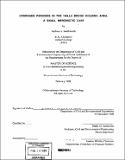| dc.contributor.advisor | Philip M. Gschwend. | en_US |
| dc.contributor.author | Southworth, Barbara A. (Barbara Anne), 1973- | en_US |
| dc.coverage.spatial | n-us-ma | en_US |
| dc.date.accessioned | 2005-09-26T19:08:35Z | |
| dc.date.available | 2005-09-26T19:08:35Z | |
| dc.date.issued | 1999 | en_US |
| dc.identifier.uri | http://hdl.handle.net/1721.1/28209 | |
| dc.description | Thesis (S.M.)--Massachusetts Institute of Technology, Dept. of Civil and Environmental Engineering, 1999. | en_US |
| dc.description | "February 1999." | en_US |
| dc.description | Includes bibliographical references. | en_US |
| dc.description.abstract | A study of hydrogen peroxide and the processes that control its concentration was carried out at the Halls Brook Holding Area (HBHA) between May 1997 and June 1998. HBHA is a small meromictic lake that receives groundwater contaminated by an adjacent Superfund site. Inflow and outflow rates and depth profiles of temperature, conductivity, dissolved oxygen, pH, and redox potential were measured at HBHA between May 1997 and June 1998. These data were used to characterize the lake structure and chemistry and to calculate groundwater inflow and vertical mixing coefficients. Hydrogen peroxide was measured at HBHA between May 1997 and February 1998. Large seasonal variations in hydrogen peroxide concentration were observed, with low (< 0.5 micromolar) concentrations in winter and higher than previously reported concentrations in the literature (up to 80 micromolar) in late summer and fall. Additionally, higher concentrations were measured in the afternoon than in the morning on one sampling date (8/14/97). During the late summer and fall, an increase in hydrogen peroxide concentrations with depth in the epilimnion was observed. Below the pycnocline, HBHA is anoxic. Hydrogen peroxide was not detected below the pycnocline on any date, and hydrogen peroxide that was added to samples below the pycnocline was rapidly destroyed. A decay rate of hydrogen peroxide was also measured in samples collected in February. The decay rate was found to be first order with respect to H20 2 with a half life of about 30 hours. Literature values for apparent quantum yields of hydrogen peroxide formation in fresh waters, solar irradiation data, the measured decay rate, and calculated turbulent diffusion coefficients were used to model expected concentrations of hydrogen peroxide in HBHA assuming that abiotic photochemical processes are the only sources. Abiotic photochemical production has been considered to be the only significant source of hydrogen peroxide in most natural fresh waters studied to date. Our modeling results did not fit the observed increase with depth within the epilimnion observed in late summer and fall. This indicates the presence of another, unknown source located near the pycnocline in summer and fall. The size and location of this source were explored using modeling, but the steep observed gradients were not successfully modeled. However, the resulting hydrogen peroxide profiles were highly sensitive to vertical diffusion coefficient values near the pycnocline, which are not well known due to a lack of data. Based on our observations, we speculate that the unknown source may be biological. The high concentrations of hydrogen peroxide have significant consequences due to possible Fenton chemistry in HBHA. With high concentrations of hydrogen peroxide in the epilimnion and previously investigated high concentrations of ferrous iron in the hypolimnion, mixing across the pycnocline may result in significant production of hydroxyl radical, which could have a significant impact on the fate of organic pollutants in HBHA. | en_US |
| dc.description.statementofresponsibility | by Barbara A. Southworth. | en_US |
| dc.format.extent | 122 leaves | en_US |
| dc.format.extent | 6320280 bytes | |
| dc.format.extent | 6335605 bytes | |
| dc.format.mimetype | application/pdf | |
| dc.format.mimetype | application/pdf | |
| dc.language.iso | en_US | |
| dc.publisher | Massachusetts Institute of Technology | en_US |
| dc.rights | M.I.T. theses are protected by copyright. They may be viewed from this source for any purpose, but reproduction or distribution in any format is prohibited without written permission. See provided URL for inquiries about permission. | en_US |
| dc.rights.uri | http://dspace.mit.edu/handle/1721.1/7582 | |
| dc.subject | Civil and Environmental Engineering | en_US |
| dc.title | Hydrogen peroxide in the Halls Brook Holding Area, a small meromictic lake | en_US |
| dc.title.alternative | Hydrogen peroxide in the HBHA | en_US |
| dc.type | Thesis | en_US |
| dc.description.degree | S.M. | en_US |
| dc.contributor.department | Massachusetts Institute of Technology. Department of Civil and Environmental Engineering | |
| dc.identifier.oclc | 42677136 | en_US |
